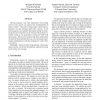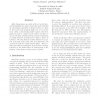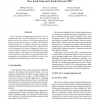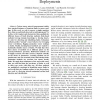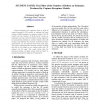99
Voted
VTS
2006
IEEE
15 years 6 months ago
2006
IEEE
A new algorithm for identifying stuck faults in combinational circuits that cannot be detected by a given input sequence is presented. Other than pre and post-processing steps, ce...
97
Voted
ISSRE
2006
IEEE
15 years 6 months ago
2006
IEEE
Moving program code that implements cross-cutting concerns into aspects can improve the maintainability of legacy systems. This kind of refactoring, called aspectualization, can a...
79
Voted
IPPS
2006
IEEE
15 years 6 months ago
2006
IEEE
A self-stabilizing protocol is a brilliant framework for fault tolerance. It can recover from any number and any type of transient faults and eventually converge to its intended b...
90
Voted
IPPS
2006
IEEE
15 years 6 months ago
2006
IEEE
In a network consisting of several thousands computers, the occurrence of faults is unavoidable. Being able to test the behaviour of a distributed program in an environment where ...
IPPS
2006
IEEE
15 years 6 months ago
2006
IEEE
After having drawn up a state of the art on the theoretical feasibility of a system of periodic tasks scheduled by a preemptive algorithm at fixed priorities, we show in this art...
DATE
2006
IEEE
15 years 6 months ago
2006
IEEE
Generation of n -detection test sets is typically done for a single fault model. In this work we investigate the generation of n -detection test sets by pairing each fault of a ta...
CLUSTER
2006
IEEE
15 years 6 months ago
2006
IEEE
One of the topics of paramount importance in the development of Cluster and Grid middleware is the impact of faults since their occurrence in Grid infrastructures and in large-sca...
95
Voted
SECON
2007
IEEE
15 years 7 months ago
2007
IEEE
—Various sensor network measurement studies have reported instances of transient faults in sensor readings. In this work, we seek to answer a simple question: How often are such ...
ETS
2007
IEEE
15 years 7 months ago
2007
IEEE
This paper summarizes advanced test patterns designed to target dynamic and time-related faults caused by new defect mechanisms in deep-submicron memory technologies. Such tests a...
99
Voted
ISSRE
2008
IEEE
15 years 7 months ago
2008
IEEE
Project managers use inspection data as input to capture-recapture (CR) models to estimate the total number of faults present in a software artifact. The CR models use the number ...

